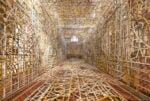Chapter 1 – The Hierarchy of Images
 (331x480).jpg)
La Galleria foto-forum intraprende con questa mostra una nuova serie di progetti che intendono proporre un confronto critico con la fotografia documentaria.
Comunicato stampa
de
Die Galerie foto-forum startet mit dieser Ausstellung eine neue Projekt-Serie, die sich kritisch mit der Kulturtechnik der dokumentarischen Fotografie auseinandersetzt. Dabei werden über einen Zeitraum von ca. 2 Jahren in mehreren Etappen jeweils herausragende Vertreter dokumentarischer Fotografie zu verschiedenen Themen eingeladen und vorgestellt. Die einzelnen Ausstellungen werden von einer Katalogreihe begleitet, wobei von Projekt zu Projekt je ein neuer Band erstellt wird. Nach Abschluss des Projektes werden alle Einzelhefte in einem gemeinsamen Buch veröffentlicht. Internationale Autoren sind mit Texten zu den einzelnen Fotografen beteiligt, sodass ein aktueller Diskurs zur kritischen dokumentarischen Praxis entsteht.
Die Bücher erscheinen bei Rorhof Verlag Bozen (Fotobuchpreis in Arles, 2014 sowie deutscher Fotobuchpreis, 2015) und in einer Sponsoring-Kooperation mit Longogroup. Für die aktuelle Ausgabe haben Marco Bohr (GB), Garry Badger (GB) und Seraphine Meya (D) Texte beigetragen.
Die Ausstellung lotet anhand der fotografischen Werke von Joachim Schmid (* 1955 in Balingen, lebt und arbeitet in Berlin), Mishka Henner (*1976 in Brüssel, lebt und arbeitet in Manchester), und Tobias Zielony (*1973 in Wuppertal, lebt und arbeitet in Berlin) spannende dokumentarische Strategien in der zeitgenössischen Fotografie aus, und durchleuchtet dabei kritisch das Thema von Hierarchien innerhalb der Praxis der dokumentarischen Fotografie. Ergänzt wird die Ausstellung durch Künstlerbücher der drei beteiligten Künstler, durch Videoportraits und durch den Ausstellungskatalog. Am Beispiel der drei fotografischen Positionen zeigen wir auf, wie mit kritischen und teils subversiven Vorgangsweisen den fotografischen Bildsystemen inhärente hierarchische Strukturen auf je unterschiedliche Weise reflektiert werden können. Dabei geht es darum, die historischen Determinierungen von fotografischen Bildern wahrzunehmen, sowie die Funktion des Mediums an seiner brüchigen Grenze zwischen Authentizität und Konstruiertheit zu diskutieren.
Mishka Henner arbeitet mit bildgebenden Systemen wie etwa den Überwachungssystemen von Google Street oder Google Earth, welche er als Bildmaterialien für seine dokumentarische Praxis verwendet. In diesem Vorgehen zieht er Parallelen zwischen dokumentarischen Praktiken und vorgeblich „objektiven“ Systemen der Bildaufzeichnung, um diese kritisch zu hinterfragen. Joachim Schmid zielt mit seiner Serie „Bilder von der Straße“, einer Reihe von Amateurschnappschüssen sowie von Automatenfotos, welche er von 1982 bis 2007 in verschiedenen Städten auf der Straße zusammensammelte, in eine sehr ähnliche Richtung, nämlich hin zur Frage, wie Fotografien, deren Autoren und deren Herkunft nicht bekannt sind, in einen klassischen Kunstdiskurs und in ein hierarchisches System von Bedeutung und Zuordnung eingefügt werden können. Tobias Zielony hingegen beschäftigt sich in seinen fotografischen Arbeiten mit der Alltagssituation von Jugendlichen an Randbereichen unserer Gesellschaft. Im Gegensatz zu Joachim Schmid und Mishka Henner bereist er die Straße mit seiner eigenen Kamera, wobei es ihm immer wieder gelingt, Menschen, welche jenseits gesellschaftlicher Normen leben, aktiv im Sinne einer Co-Autorenschaft in seine fotografischen Projekte zu involvieren.
Fotokünstler mit einem kritischen Ansatz gehen in der Frage nach der dokumentarischen Praxis ganz neue Wege, mit dem Ziel, auf angemessene und kontemplative Weise gesellschaftliche Realitäten zu erfassen. Sie nehmen sich die Zeit, Hintergründe zu erschließen, Stereotypen zu kritisieren und komplexere Darstellungsmöglichkeiten auszutesten. Und letztlich ist es nur durch einen offensiven Umgang mit den eigenen künstlerischen Vorgangsweise möglich, das System der Macht der Bilder und der unbewussten Erzählmuster aufzudecken, indem die technischen, diskursiven und narrativen Werkzeuge reflektiert werden, mit denen die Realität anhand von fotografischen Bildern konstruiert wird.
it
La Galleria foto-forum intraprende con questa mostra una nuova serie di progetti che intendono proporre un confronto critico con la fotografia documentaria. L’iniziativa prevederà che, per un periodo di circa 2 anni, vengano invitati eccellenti esponenti della fotografia documentaria e presentata la loro opera su diversi temi e in diverse fasi. Le singole mostre verranno accompagnate da una collana di cataloghi che prevedanno un volume distinto per ogni singolo progetto. A conclusione dell’iniziativa tutti i singoli volumi verranno pubblicati in un libro comune. Autori internazionali parteciperanno con i loro testi sui singoli fotografi, in modo che si sviluppi un discorso contemporaneo critico sulla pratica della fotografia documentaria.
I libri verranno pubblicati dalla casa editrice Rorhof di Bolzano (Premio libro fotografico ad Arles 2014 e Deutscher Fotobuchpreis 2015) ed editi in una collaborazione-sponsoring con Longogroup. Per il numero attuale hanno contribuito Marco Bohr (GB), Garry Badger (GB) e Seraphine Meya (D).
La mostra esplora, attraverso le opere fotografiche di Joachim Schmid (* 1955 a Balingen, vive e lavora a Berlino), Mishka Henner (*1976 a Bruxelles, vive e lavora a Manchester) e Tobias Zielony (*1973 a Wuppertal, vive e lavora a Berlino), interessanti strategie documentarie nella fotografia contemporanea ed esamina criticamente il tema delle gerarchie all’interno della pratica della fotografia documentaria. La mostra propone inoltre libri degli artisti coinvolti, ritratti video e un catalogo. Partendo da queste tre posizioni fotografiche, si mostrano come possano essere affrontate e pensate, con un approccio critico e in parte sovversivo, e in tre modi molto diversi, le strutture gerarchiche inerenti ai sistemi dell’immagine fotografica. Si tratta di percepire le determinazioni storiche delle immagini fotografiche e di discutere la funzione del mezzo fotografico lungo il suo fragile confine tra autenticità e costruzione.
Mishka Henner lavora con sistemi che producono immagini, come per esempio i sistemi di sorveglianza Google Street o Google Earth, le cui immagini vengono usate come materiale per la sua pratica documentaria. In questo suo procedimento traccia parallelismi tra le pratiche documentarie e i presunti sistemi “oggettivi” di registrazione di immagini, per poi indagarli criticamente. Joachim Schmid, con la serie “Immagini dalle strade” - una serie di istantanee e di fotografie amatoriali che ha raccolto tra il 1982 e il 2007 nelle strade di diverse città – si muove in una direzione simile. Si chiede come le fotografie possano, non conoscendo né l’autore né la provenienza, essere inserite in un discorso classico sull’arte e in un sistema gerarchico di ordine e di significato. Tobias Zielony, invece, si occupa nei suoi lavori fotografici di situazioni quotidiane di giovani ai margini della nostra società. Al contrario di Joachim Schmid e Mishka Henner percorre le strade con la sua macchina fotografica e riesce a coinvolgere attivamente come co-autori dei suoi progetti fotografici persone che vivono al di là delle norme sociali.
Gli artisti visuali con un approccio critico aprono nuovi sentieri per quanto riguarda la pratica della fotografia documentaria, con l’obiettivo di cogliere le diverse realtà sociali in maniera adeguata e contemplativa. Si prendono il tempo di esplorare i retroscena, di criticare gli stereotipi e di provare modalità complesse di rappresentazione. Solo un atteggiamento critico verso i propri procedimenti artistici, infatti, rende possibile svelare il sistema di potere delle immagini e dei modelli narrativi inconsci, riflettendo sugli strumenti tecnici, discorsivi e narrativi con i quali si costruisce la realtà per mezzo delle immagini fotografiche.
en
This exhibition launches a new project series at gallery foto-forum that critically engages with the cultural technique of documentary photography. During the course of two years and through multiple stages, outstanding exponents of documentary photography will be asked to exhibit on a whole array of issues. The individual exhibitions will be accompanied by a series of catalogues, and from one project to the other a new volume will be created for each. After the project's completion, all single issues will be republished as one book. International authors contribute texts on the individual photographers in order to create an up-to-date discourse on critical documentary practices.
The books will be published at Rorhof Verlag Bozen (which received the 2014 photobook-prize in Arles, and the german photobook-prize in 2015), and in sponsoring cooperation with Longogroup. Marco Bohr (GB), Garry Badger (GB) and Seraphine Meya (DE) contributed texts to the current issue.
Through the photographic works of Joachim Schmid (born 1955 in Balingen, lives and works in Berlin), Mishka Henner (born 1976 in Brussels, lives and works in Manchester) and Tobias Zilony (born 1973 in Wuppertal, lives and works in Berlin), the exhibition explores exiting documentary strategies in contemporary photography and critically screens the issue of hierarchies within the practice of documentary photography. The exhibition will be complemented by artist's books featuring the three participants as well as video portraits and the exhibition catalogue. Using the example of these three photographic positions, we demonstrate how hierarchical structures intrinsic to the pictorial regimes of photography can be reflected in different ways by means of critical and sometimes subversive procedures. What is at issue here is to become aware of the historical determinations of photographic imagery, and to discuss the function of the medium at its fragile border between authenticity and construction.
Miskha Henner works with imaging systems like e.g. the surveillance apparatuses of Google Street View or Google Earth, which he uses as pictorial materials for his documentary practice. With this procedure he draws a parallel between documentary practices and allegedly 'objective' systems of image recording in order to critically scrutinize them. Joachim Schmid with his series "Pictures from the Street" (Bilder von der Stra?e), an array of snapshots and amateur photographs he collected between 1982 and 2007 on the streets of multiple cities, is heading into a similar direction, namely towards the question how photographs whose authors and origin are unknown can be inserted into a classical art discourse and a hierarchical system of meaning and attribution. Tobias Zilony, on the other hand, in his photographic work is dealing with everyday life situations of juveniles at the margins of our society. Contrasting Joachim Schmid and Miskha Henner, he travels the street with his own camera, where time and again he manages to actively involve people living beyond societal norms as co-authors of his photographic projects.
Photo artists with a critical approach are breaking wholly new ground on the question of documentary practice with the aim of capturing societal realities in an adequate and contemplative way. They are taking their time to unlock the backgrounds, criticize stereotypes and test more complex ways of representation. And ultimately, only through a more open handling of one's own artistic procedures it is possible to uncover the system of the power of images and the unconscious patterns of narration, — by way of reflecting upon the technological, discursive and narrative tools that are utilized to construct reality through the photographic image.



